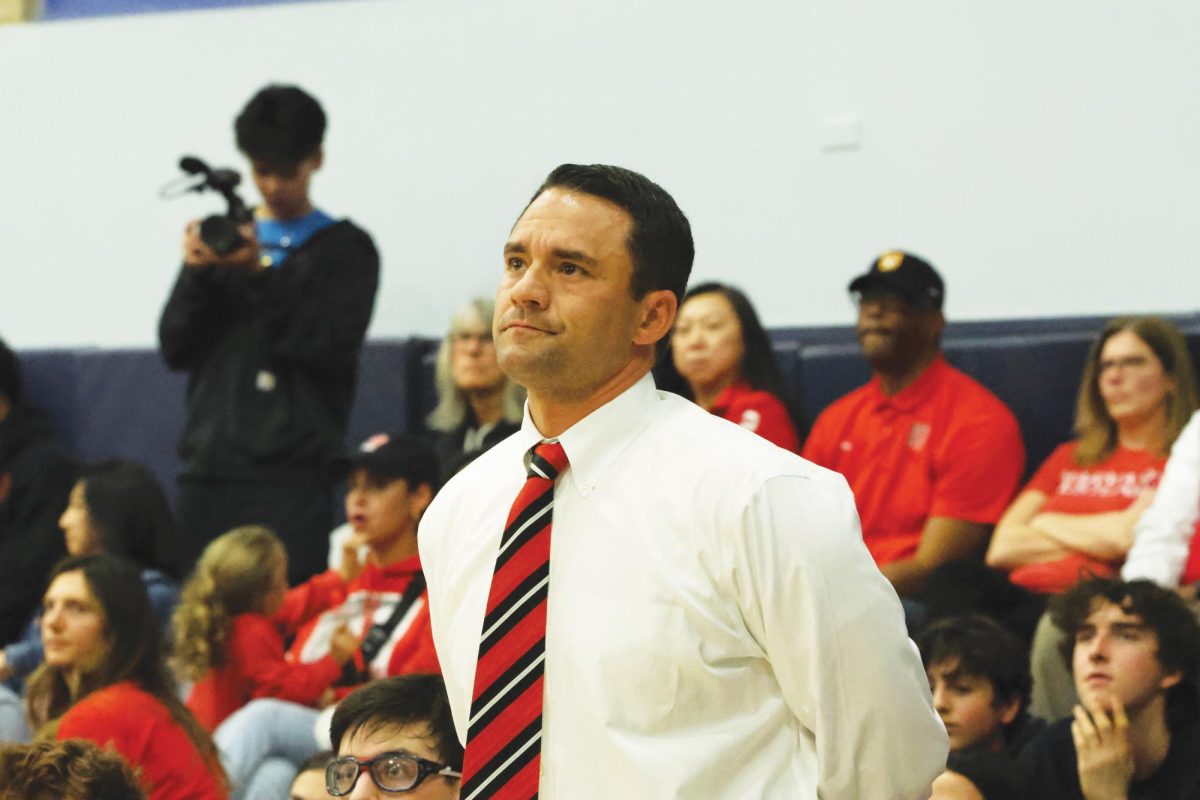By Luke Holthouse
A shirtless Beau McGinley ’13 steps onto the dynabiopsy machine inside the upper school weight room. Jose Soto of the Milan Lab asks McGinley how tall he is.
“5-feet, 11 [inches],” answers the varsity boys’ soccer midfielder.
Soto asks his assistant Lucca Bongarra to plug that value into the metric unit conversion app on his iPhone. Lucca tells Soto to type 1.80 meters into MilanLab computer program, and the test is ready to go.
Soto sticks two motion sensors to McGinley’s hips and instructs McGinley to stand in between another motion sensor lying on the padded mats of the weight room. The three sensors are connected to Soto’s laptop computer and provide all the data needed to calculate the efficiency of McGinley’s jumping technique. Soto tells McGinley to wait a couple of seconds in a squat before exploding into a jump.
As McGinley lands on the mat, the program measures the amount of force in his jump and identifies the muscle groups that provided the energy. The program detects whether a muscle group in McGinley’s legs is strong and in shape, or is weak and in need of rest.
The dynabiopsy machine is just one of three parts of the MilanLab that Soto and his staff demonstrated for Harvard-Westlake.
The MilanLab is a unique applied kinesiology database that uses information about an athlete and helps model a workout regimen for that athlete. Head Athletic Trainer Milo Sini said that the program has been very successful for the team, as many of the players on AC Milan are relatively old for professional soccer players, but have managed to avoid injury and keep the team competitive.
“AC Milan is probably the only team in the world who has perfected, through the MilanLab, a data collecting ability to monitor a soccer player through the age of six to the professional level in multiple variables.” Sini said.
Soto said that the philosophy behind the MilanLab is to build a comprehensive plan for each individual athlete that uses all possible technologies to maximize the player’s performance on the field.
“The philosophy is to use all the expertise of this human and technological and scientific resources of AC Milan,” Soto said. “You use all of this together to give the player the greatest training experience possible.”
Soto also emphasized the importance of structuring the MilanLab program for each individual player differently.
“At the end of the day, the most important person is the individual player,” Soto said. “The key is to recognize differences and by me having a deep understanding of your characteristics, I can make you better.”
Besides the jumping tests with the dynabiopsy machine, Soto tested both the miniature heart rate monitor and the ultrasound body mass indicator. The miniature heart rate monitor calculated whether each athlete’s heart was working too hard to pump blood across their body, indicating that the athlete needed more rest. The body mass indicator gave specific results on the body and muscle type of each athlete, which helps Soto specialize his training for each individual.
Sini said that Harvard-Westlake hopes to incorporate some of the MilanLab technologies into the Harvard-Westlake sports program, but that the program hasn’t figured out how they would use the technology yet. He also said that Harvard-Westlake trainers and soccer coaches can learn from the perspective of AC Milan trainers and coaches by interacting with them on the project.
Head of Athletics Audrius Barzdukas said that AC Milan hopes to develop its brand in the United States with the help of Harvard-Westlake. He added that in the future, AC Milan may look to Harvard-Westlake to be the headquarter of its youth development program in southern California.
The current youth development team in Los Angeles practices on the Ted Slavin Field and features several players who aren’t yet Harvard-Westlake students, but are members of the Harvard-Westlake community. Barzdukas’ son, Rimas, and middle school English teacher Jennifer Dohr’s son, Lucca, are both players on the AC Milan youth development team.
Barzdukas hopes that the boys’ and girls’ soccer programs introduce a school-based club team that would allow players to stick with their teammates and coaching staff during the offseason.
“It’s a little crazy for a kid to play for one coach for five months of the year and then come play for another coach for five months of the year,” Barzdukas said. “If we can find some way to keep kids playing together over the longer term, they’ll get to know each other so they can build talent on top of talents.”
Barzdukas said that AC Milan and Harvard-Westlake became interested in each other because they are both members of the Scholastic Institute for Sports Science and Medicine.
“I look at it as two elite brands coming together to form a unique partnership,” Barzdukas said. “We’re one of the best schools in the world. They’re one of the best soccer clubs in the world. And we both happen to be in the kid development business. I think the results of that partnership will be exciting for both organizations. We’re just getting started, we’re just getting it going.”





































